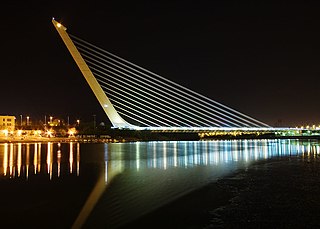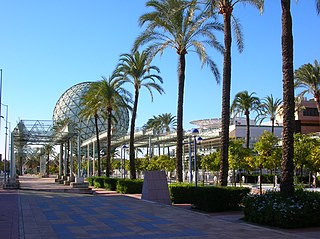
The Alamillo Bridge is a structure in Seville, Andalucia (Spain), which spans the Canal de Alfonso XIII, allowing access to La Cartuja, a peninsula located between the canal and the Guadalquivir River. The bridge was constructed as part of infrastructure improvements for Expo 92, which was held on large banana farms on the island. Construction of the bridge began in 1989 and was completed in 1992 from a design by Santiago Calatrava.

A cantilever spar cable-stayed bridge is a modern variation of the cable-stayed bridge. This design has been pioneered by the structural engineer Santiago Calatrava in 1992 with the Puente del Alamillo in Seville, Spain. In two of his designs the force distribution does not depend solely upon the cantilever action of the spar (pylon); the angle of the spar away from the bridge and the weight distribution in the spar serve to reduce the overturning forces applied to the footing of the spar. In contrast, in his swinging Puente de la Mujer design (2002), the spar reaches toward the cable supported deck and is counterbalanced by a structural tail. In the Assut de l'Or Bridge (2008), the curved backward pylon is back-stayed to concrete counterweights.

Panama's Centennial Bridge is a major bridge crossing the Panama Canal. It was built to supplement the overcrowded Bridge of the Americas and to replace it as the carrier of the Pan-American Highway. Upon its opening in 2004, it became the second permanent crossing of the canal.

Puente la Reina is a town and municipality located in the autonomous community of Navarre, in northern Spain.

Isla de la Cartuja is an island in the Guadalquivir River at Seville, Spain.

Puente Aranda is the 16th location of the Capital District of the Colombian capital city, Bogotá. It is located in the center part of Bogotá. This district is mostly inhabited by lower middle and working class residents. The district was named after an old bridge in the hacienda of Juan Aranda over the "Chinúa River", now called the San Francisco River, that dates to the 16th century. Puente Aranda has 1,724 hectares of area which are almost entirely urban. This locality has more than 300,000 inhabitants, 5% of the total urban area inhabitants of Bogota.

Triana is a neighbourhood and administrative district on the west bank of the Guadalquivir River in the city of Seville, Spain. Like other neighborhoods that were historically separated from the main city, it was known as an arrabal. Triana is located on a peninsula between two branches of the Guadalquivir, narrowly linked to the mainland in the north. Two other districts are also usually included in this area, Los Remedios to the south and La Cartuja to the north.

Los Remedios is a district of Seville, the regional capital of Andalusia, Spain. It is located on the Isla de La Cartuja, south of the district of Triana, between two forks of the Guadalquivir river. It is linked by bridge to the city centre and the districts of Distrito Sur and Bellavista-La Palmera. From the western side of the island, it is linked by road bridge to the city of San Juan de Aznalfarache and shares a boundary in the Guadalquivir with the city of Gelves. The southern tip of La Cartuja is opposite the municipality of Dos Hermanas.

The Puerta del Puente is a Renaissance gate in Córdoba, Andalusia. Built in the 16th century to commemorate a visit to the city by King Philip II, the gateway is located on the site of the previous Roman gates, linking the city with the Roman bridge and the Via Augusta.

The Goya murals in the Cartuja de Aula Dei are a cycle of mural paintings on the Life of the Virgin by Francisco de Goya, realised in secco, in the church of the Charterhouse of Aula Dei near Peñaflor de Gállego on the outskirts of Zaragoza, Aragon, Spain.

Acacias or Las Acacias is an administrative neighborhood (barrio) of Madrid belonging to the district of Arganzuela. It has an area of 1.074172 km2 (0.414740 sq mi). As of 1 February 2020, it has a population of 37,049.

Seville, the capital of the region of Andalusia in Spain, has 11 districts, further divided into 108 neighbourhoods.
The following is a timeline of the history of the city of Seville, Andalusia, Spain.

Ayala Bridge is a steel truss bridge over the Pasig River in Manila, Philippines. It connects the districts of Ermita and San Miguel, passing over the western tip of Isla de Convalecencia. It carries Circumferential Road 1 (C-1) and National Route 180 (N180), linking Ayala Boulevard in Ermita to P. Casal Street in San Miguel.

The Alcantara Gate is a city gate located in Toledo, in Castile-La Mancha, Spain. It gives access to the interior of the historic center of the city, passing through its eastern side the surrounding wall. It is in front of the bridge called Puente de Alcántara, that crosses the Tagus river and that in turn is protected by two gates fortified in its ends.

The Puerta del Reloj, Torre del Reloj or Boca del Puente is the main city gate of the historic center of Cartagena de Indias, in Colombia and the original entrance of the fortified city. It is located between the squares Plaza de Independencia and Plaza de los Coches. The name "Puerta del Reloj" responds to the clock with which it was crowned at the beginning of the 18th century. While the name of Boca del Puente is due to the fact that during the colonial period, a drawbridge was raised at the foot of the channel of San Anastasio, which linked the walled city to the legendary Getsemaní neighborhood. In addition the bridge served like defense of the city, since in case of enemy attack, this one was raised to prevent the access of buccaneers and pirates.

The Currents Bridge, is a tied-arch bridge that crosses the Lérez River in the city of Pontevedra, Spain. It was inaugurated in 2012 and connects Uruguay Avenue and Domingo Fontán Street.

Las Fuentes is a district of Zaragoza (Spain). It borders the districts of Casco Antiguo, Torrero - La Paz and San José and the municipalities of Pastriz, El Burgo de Ebro, Fuentes de Ebro and Mediana de Aragón. In addition to the neighborhood of Las Fuentes, it includes others such as Montemolín or the area surrounding the Pabellón Príncipe Felipe. It extends as far as the neighborhood of La Cartuja. Its borders are delimited by the rivers Ebro, Huerva, Miguel Servet Street and the railway bypass.


















